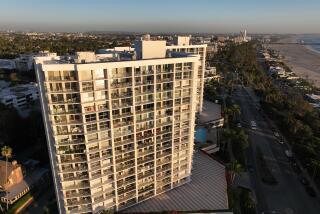Great Park audit testimony paints picture of runaway project

Testimony from an audit of the $200-million effort to transform a retired Orange County military base into one of America’s great municipal parks paints a picture of a runaway project that was eventually crippled by waste, dysfunction and cronyism.
Former park officials said the Great Park project was commandeered by a longtime Irvine councilman, and described the design process under his watch as so disorganized that it was, at one point, likened to a ship adrift at sea.
Councilman Larry Agran, an ardent booster of the park, fostered an environment of cronyism by bringing aboard consultants who served as his chief lieutenants and giving them nearly unchecked power, the transcripts suggest.
Transcripts were released ahead of a full forensic audit of Great Park spending, and auditors had the power to subpoena witnesses for their work. The audit is examining how Irvine spent more than $200 million on plans for the 1,300-acre park with little developed land to show for it.
Witnesses deposed for the audit said the consultants — one with a long, colorful history in California politics — were allowed to rack up enormous bills as they championed virtually impossible visions.
“Once Larry Agran and his group took control of this thing, there were no budgets,” testified former Irvine Co. Chief Executive Richard Sim, who served on the Great Park board. “It was like the sky was the limit.”
Sim said contracts were not properly put out to bid and, instead, were steered to the councilman’s associates — people whom city staffers derisively referred to as “FOL,” or “Friends of Larry.”
Sim said a disregard for good business practices, and the fear of potential illegal activity, drove him to resign from the board after about two years.
Agran, who served as chairman of the Great Park Corp. for five of the seven years covered by the audit, dismissed accusations that project consultants were allowed to run freely under his watch, saying such criticism is unfounded and politically motivated.
“This is a taxpayer-funded political witch hunt,” he said, stressing that his critics have failed to “find even one dollar unaccounted for.”
What started out as a vision for a showpiece in the vein of San Diego’s Balboa Park or even New York City’s Central Park has now been scaled back. A builder has agreed to develop a golf course, sports complex and other amenities on a portion of the old base in exchange for the right to build thousands of homes along the park’s perimeter.
“We had a saying among the insiders,” testified William Kogerman, a former Great Park board member and a retired Marine. “We never seem to have enough money to do it right, but we always have enough money to do it over.”
Kogerman said he had an uneasy feeling of constant whiplash during his tenure.
Ideas that seemed to gain traction among board members would be dropped without explanation, while others — such as a canyon carved from the earth — were allowed to proceed without realistic assessments of their feasibility, he testified.
“The idea of being able to build a canyon and a lake and a cultural center and stay within what everybody was talking about at the time, a $1.3-billion budget, was lunacy,” Kogerman said.
Meanwhile, Great Park officials testified that consultants with close ties to Agran treated city staff members like their employees, rather than the other way around.
Brendan McDevitt, a consultant brought aboard as an advocate for the city, said staffers from the consulting firm Gafcon, who ran the Great Park Design Studio along with designer Ken Smith, resisted his attempts to get a handle on the firm’s expenses. He testified that they referred questions further up the chain of command.
“If there was a name-drop opportunity, they would do it,” he testified.
Mike Ellzey, the former Great Park Corp. chief executive and now Irvine’s assistant city manager, testified that Gafcon’s owner, Yehudi Gaffen, seemed to have Agran’s ear — and that as a result, design studio staff members were able to operate uninhibited by the city’s concerns.
In a statement responding to the testimony, officials at Gafcon rejected claims of wrongdoing, calling them “At best ... gross misstatements of the facts, and at worst ... direct lies.”
In another statement, Gafcon defended its work at the Great Park Design Studio, saying it was completed “on time and under budget.”
Similarly, officials said, political consultant Arnold Forde’s firm, Forde & Mollrich, was awarded exorbitant no-bid contracts to publicize the park because of Forde’s ties to Agran.
Asked whether he thought Agran was directing Forde — whose firm was being paid a $100,000 monthly retainer for its work on the park — or if Forde was directing Agran, Sim responded, “I was never sure.”
Forde’s partner, Stu Mollrich, questioned the validity of the testimony, adding that “it is no coincidence this so-called audit is scheduled to be released immediately in advance of November elections.”
Mollrich said that he had already been deposed as part of the audit, and that Forde is still scheduled to speak with audit attorneys.
Agran, too, disputed claims that his relationships with any contractors were out of line.
Ultimately, he said, he’s proud of the park features that have been built, such as the iconic orange Great Park balloon.
“I viewed my job as chair as being to encourage and facilitate. Some people thought that was unwanted activism — that’s too bad,” he said. “It’s not my problem and it shouldn’t be the public’s problem.”
Irvine Mayor Steven Choi, who has pushed hard for an accounting of the Great Park spending, doesn’t see it that way.
“People can read the direct words that appeared in the depositions,” he said. “From that view, it is quite alarming that all the finger-pointing goes to one individual — and you know who that person is.”
In addition to the problems outlined in the testimony, the park’s planning was hindered by the economic downturn, housing market woes and the loss of a key funding source for the project.
More to Read
Start your day right
Sign up for Essential California for news, features and recommendations from the L.A. Times and beyond in your inbox six days a week.
You may occasionally receive promotional content from the Los Angeles Times.






